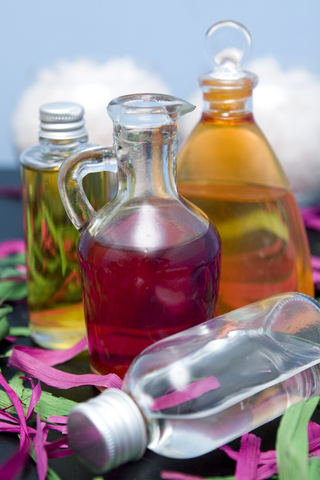Before blending essential oils it’s important to understand that essential oils have differences in the holding power of their essence (scent). Blend essential oils using a combination of three classe: top note, middle note, and base note.
- Top note – These oils are light and energizing, but have short staying power due to their fast rate of evaporation. Orange, lemon and Eucalyptus are examples of top note essential oils.
- Middle note – These oils are heavier, more potent and have a slower rate of evaporation. They make up the bulk of the essential oil blends. Geranium, rosemary and ylang ylang are examples of middle note oils.
- Base note – The heaviest oils form this group. They have the slowest evaporation rate therefore linger the longest. Clove, cedarwood, and rose are three examples of base note oils.
When you’re experimenting with oil blends, it’s a good idea to consider where on the keyboard of scents the oil falls. However, in your quest for that perfect scent, you may choose to ignore that altogether and surge forward with careless abandon. That’s perfectly okay as long as you understand what to expect from the blend you choose.
The goal in blending oils is to determine which combination of scents produces the desired effect. Say you want to add lemon (top note), rosemary (middle note), and clove (base note) together. You think that would be a great combination for a soap making project. However, you’re smart and don’t want to proceed without knowing if this combination is going to give the desired scent.
- First you gather several small jars with lids, your essential oils and a package of Q tips.
- Now place all three jars of essential oil side by side and open them. Take care not to lean your nose too close to them. This can ruin your ability discern the essence of your blend correctly as essential oils are potent when whiffed full strength. Waft the combined scents toward your nose with your hand.
- Take a Q tips and dip it into one of your essential oils then place the Q tip into one of your empty jars. Repeat the process with the remaining two jars.
- Cap off your jars of essential oil and waft the jar containing the blend of oils toward your nose. Is it the scent you desired? Make note of your reaction to the blend. How did it make you feel?
- Repeat the process of opening and wafting after 1 hour, 6 hours, 12 hours, 24 hours and 48 hours. Make note of how the scents change over time.
- Keep experimenting until you are satisfied with the blend.
Notes:
- If you want to experiment with different concentrations of the same oils, use an eye dropper, but take care to use a clean dropper for each essential oil or they will end up contaminated.
- Don’t overload your scent receptors. Three whiffs and your out is a general rule. Wait three minutes between whiffs or your brain will give you skewed results. Sniffing coffee beans will help clear your scent receptors.
- Store your essential oils and your test jars in a cool dark place.
Blend essential oils using your favorite scents. Try experimenting using your favorite scents to come up with a fragrance that’s customized just for you.
Now go have fun and relax.
Related articles:
Top 10 Essential Oils – A Primer of Uses, Warnings and Blends
How to Choose the Right Essential Oils

